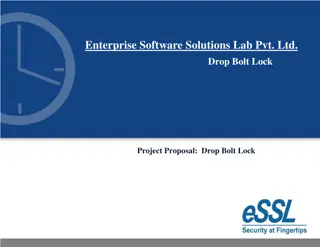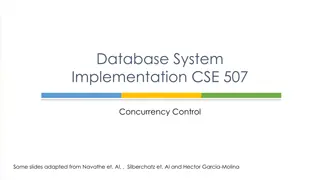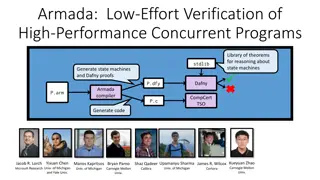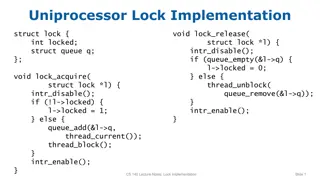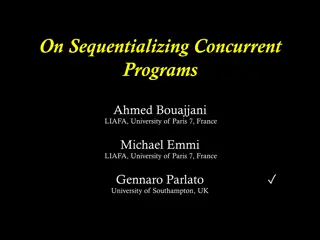Understanding Lock-Free and Wait-Free Algorithms in Concurrent Data Structures
Illustration of lock-free and wait-free algorithms compared to blocking algorithms, with insights on concurrent object execution, blocking vs. non-blocking algorithms, definitions, comparisons between locks, lock-free, and wait-free approaches, and explanations on making algorithms wait-free. Examples of temporary fields, packing, and redirection in concurrent data structures are also explored.
- Concurrent Data Structures
- Lock-Free Algorithms
- Wait-Free Algorithms
- Blocking vs Non-Blocking
- Temporary Fields
Download Presentation

Please find below an Image/Link to download the presentation.
The content on the website is provided AS IS for your information and personal use only. It may not be sold, licensed, or shared on other websites without obtaining consent from the author. Download presentation by click this link. If you encounter any issues during the download, it is possible that the publisher has removed the file from their server.
E N D
Presentation Transcript
Expander: Lock-free Cache for a Concurrent Data Structure POOJA POOJA AGGARWAL AGGARWAL (IBM RESEARCH, BANGALORE) SMRUTI SMRUTI R. R. SARANGI SARANGI (IIT DELHI) 1
Concurrent Object Each thread executes a method on the object method Concurrent Object Threads request response method Thread 1 Thread 2 Linearizability Thread 3 Timeline 2
Blocking vs Non-blocking Algorithms Blocking algorithm with a lock Non-blocking algorithm lock val = acc.balance acc.balance += 100 unlock return val val = acc.balance. fetchAndAdd (100) return val 3
Few Definitions Blocking algorithm with locks Only one thread is allowed to hold a lock and enter the critical section Lock-free algorithms There are no locks At any point of time at least one thread makes progress and completes the operation Wait-free algorithms Every request completes in a finite amount of time. 4
Comparison Between Locks, Lock-free, and Wait-free Disjoint Access Parallelism Finite Execution Time Starvation Freedom With Locks Lock-free Wait-free 5
Why not make all algorithms wait-free? Locks Lock-free Wait-free Easy to program Starvation, Blocking, No disjoint access parallelism Need a black belt in programming 6
Example of Temporary Fields while(true) { <val, ts> = acc.balance; newval = val + 100; newts = ts + 1; if (CAS (acc.balance, <val,ts>, <newval,newts>)) break; } while(true) { val = acc.balance; newval = val + 100; if (CAS (acc.balance, val, newval)) break; } CAS CompareAndSet CAS (val, old, new) if (val == old) val = new; Temporary Field balance value timestamp 7
Packing Temporary Fields Value Field1 Field2 Field3 Memory Word Size of a field is restricted by the size of the memory word 8
Redirection Object Value Pointer Field1 Field2 Field3 Lot of memory wastage. 9
Examples of Packing and Redirection Packing Paper Authors Temporary Fields Wait-free multiword CAS Universal construction Sundell Anderson et al. index, thread id, descriptor thread id, valid bit, count Wait-free slot scheduler Aggarwal et al. request id, thread id, round, timestamp, slot number, state Redirection Paper Authors Temporary Fields Wait-free queue Kogan et al. enqueue id, dequeue id Wait-free priority queue Israeli et al. value, type, freeze bit Wait-free linked list Timnat et al. mark bit and success bit 10
Idea of the Expander Program Memory Space Expander The Expander works as a cache It caches the value of a memory word and the temporary fields If the word is not required, its value is flushed to memory, and the temporary fields are removed Advantages: Any number of temporary fields with arbitrary sizes Makes packing feasible, and eliminates the memory overhead of redirection 11
Design of the Expander Node of type MemCell Memory Word value Hash memIndex tmpFields dataState Hash Table (listHead) next version state reference timestamp mark bit 12
Basic Operations kGet Get the value of a memory word along with temporary fields kSet Set the value of a memory word and its fields kCAS Compare the value and all the fields, and if all of the match, then do a kSet free Remove the entry of the Expander 13
FSM of an Expanders Node kSet/kCAS CLEAN DIRTY kGet kSet/kCAS/kGet free free kGet WRITE BACK FLUSH kSet/kCAS/kGet 14
kGet Is the word there in the Expander? No Yes Return the value and the temporary fields Read the value from memory Use default values for the temporary fields 15
kCAS node lookUpOrAllocate() do all the values/fields match? No Yes node.state == FLUSH help delete No Yes create a new version set state to DIRTY set a new dataState return false if not successful return false else return true 16
free if state == WRITEBACK or FLUSH Yes No return false state = WRITEBACK state = FLUSH help delete write to memory 17
Proofs and Example All methods are linearizable and lock-free If we consider a special set of wait-free algorithms where a request is guaranteed to complete if at least one thread handling it has completed N steps the algorithm remains wait-free with the Expander The paper shows a wait-free queue with the Expander code changes in only 8 lines 18
Evaluation Setup Dell PowerEdge R820 Server Four socket, each socket has an 16-thread 2.2 GHz Xeon Chip 16 MB L2 cache, and 64 GB main memory Details of the Machine Ubuntu 12.10 and Java 1.7 Use Java s built-in totalMemory and freeMemory calls 1-6 temporary fields Additional: 1-62 bits Software Packing Redirection Wait-free multi-word compare-and-set Wait-free slot scheduler Slot scheduler for SSD devices (RADIR) Wait-free queue Lock-free linked list and binary search tree Lock-free skiplist 19
Slowdown (with 64 threads) 32 threads 2-20% Slowdown 20
Reduction in Memory Usage (Redirection) 5-35% reduction in the memory footprint 21
Conclusions The Expander has many advantages Makes algorithms with packing feasible Reduces the memory footprint of algorithms with redirection by up to 35% Minimal modifications in the code Most wait-free algorithms remain wait-free with the Expander 22


